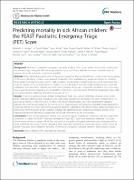| dc.identifier.citation | George, E. C., Walker, A. S., Kiguli, S., Olupot-Olupot, P., Opoka, R. O., Engoru, C., ... & Babiker, A. G. (2015). Predicting mortality in sick African children: the FEAST paediatric emergency triage (PET) score. BMC medicine, 13(1), 1-12. | en_US |
| dc.description.abstract | Background: Mortality in paediatric emergency care units in Africa often occurs within the first 24 h of admission
and remains high. Alongside effective triage systems, a practical clinical bedside risk score to identify those at
greatest risk could contribute to reducing mortality.
Methods: Data collected during the Fluid As Expansive Supportive Therapy (FEAST) trial, a multi-centre trial involving
3,170 severely ill African children, were analysed to identify clinical and laboratory prognostic factors for mortality.
Multivariable Cox regression was used to build a model in this derivation dataset based on clinical parameters that
could be quickly and easily assessed at the bedside. A score developed from the model coefficients was externally
validated in two admissions datasets from Kilifi District Hospital, Kenya, and compared to published risk scores using
Area Under the Receiver Operating Curve (AUROC) and Hosmer-Lemeshow tests. The Net Reclassification Index (NRI)
was used to identify additional laboratory prognostic factors.
Results: A risk score using 8 clinical variables (temperature, heart rate, capillary refill time, conscious level, severe
pallor, respiratory distress, lung crepitations, and weak pulse volume) was developed. The score ranged from 0–10
and had an AUROC of 0.82 (95 % CI, 0.77–0.87) in the FEAST trial derivation set. In the independent validation
datasets, the score had an AUROC of 0.77 (95 % CI, 0.72–0.82) amongst admissions to a paediatric high dependency
ward and 0.86 (95 % CI, 0.82–0.89) amongst general paediatric admissions. This discriminative ability was similar to, or
better than other risk scores in the validation datasets. NRI identified lactate, blood urea nitrogen, and pH to be
important prognostic laboratory variables that could add information to the clinical score.
Conclusions: Eight clinical prognostic factors that could be rapidly assessed by healthcare staff for triage were
combined to create the FEAST Paediatric Emergency Triage (PET) score and externally validated. The score
discriminated those at highest risk of fatal outcome at the point of hospital admission and compared well to
other published risk scores. Further laboratory tests were also identified as prognostic factors which could be
added if resources were available or as indices of severity for comparison between centres in future research studies. | en_US |

